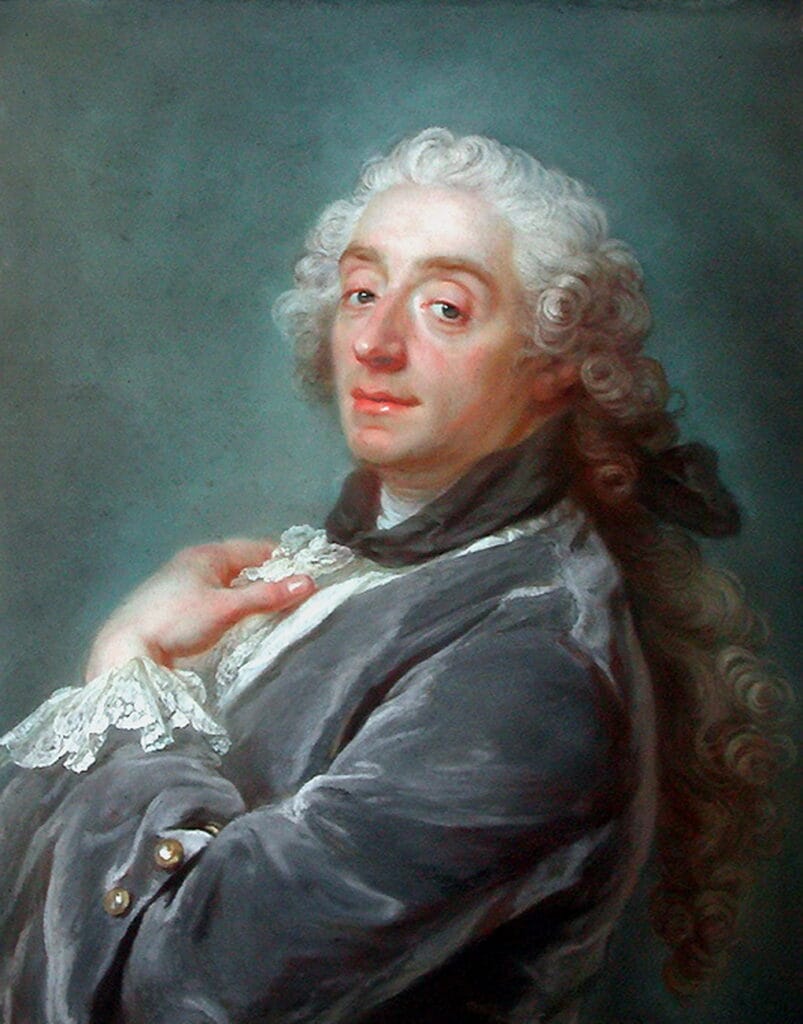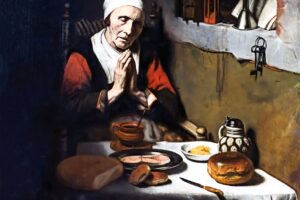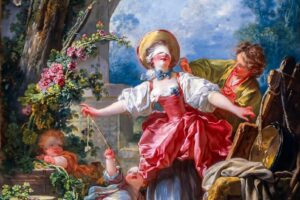Imagine a sunny day filled with laughter, gentle music, and quiet conversations beside a sparkling fountain. That’s exactly the enchanting scene François Boucher captures in his lovely painting The Fountain of Love, created in 1748. Boucher, a master painter of the Rococo style, was famous for his graceful scenes of romantic charm, nature’s beauty, and gentle enjoyment.
Romance by the Fountain
At the heart of the painting is a charming garden fountain, beautifully decorated with graceful sculptures and cascading water. Around this fountain, several couples and playful putti relax, talk, and enjoy the warmth of the day. Boucher shows us tender moments of connection, gentle conversation, and shared happiness.
Moments of Gentle Enjoyment
Throughout the scene, we see beautifully dressed figures enjoying simple pleasures:
- Quiet Conversations: Near the fountain, couples talk softly, exchanging sweet smiles and affectionate glances. Their colorful gowns and relaxed poses suggest a joyful gathering among friends or lovers.
- Playful Putti: Adorable cherub-like putti appear throughout the scene, happily playing among animals, adding touches of innocence and playful charm to the painting.
- Animals at Rest: Gentle goats and fluffy sheep relax peacefully nearby, highlighting the pastoral, calm atmosphere. These animals represent simplicity, innocence, and the peaceful nature of rural life.
- Music and Flowers: On the right, a young man plays a gentle tune on his flute, capturing the heart of a lovely lady beside him. Nearby, colorful flowers spill from a basket, adding a sense of freshness and beauty to this charming moment.
A Picturesque Setting
Boucher places this joyful gathering in a delightful countryside landscape:
- The Graceful Fountain: The fountain, with its softly cascading waters and charming sculptures, serves as the focal point, symbolizing love, refreshment, and renewal.
- Peaceful Architecture: In the background stands a charming rustic building, adding to the sense of countryside tranquility. Its warm stone walls blend beautifully with the lush greenery and blue skies above.
- Nature’s Harmony: Tall, graceful trees frame the painting, while soft clouds drift gently across a bright sky. Each detail combines beautifully to create a scene full of harmony and natural beauty.
Love and Friendship
François Boucher’s The Fountain of Love invites us into a gentle, romantic world, celebrating love, friendship, and the joys of everyday pleasures. His soft brushstrokes, graceful figures, and lively colors beautifully capture the elegance and charm of the Rococo period.
Through this delightful painting, Boucher reminds us of the simple happiness found in spending peaceful moments with those we care about, surrounded by the beauty of nature.
About Artist

François Boucher (1703–1770) was a French painter, a dominant figure of the Rococo art movement. He was the most celebrated artist of his time, serving as the official court painter to King Louis XV and working closely with the king’s chief mistress and art patron, Madame de Pompadour. His style is the very essence of Rococo: playful, sensuous, and highly decorative, focusing on mythological, allegorical, and pastoral scenes.
Artistic Style and Legacy
Boucher’s style is characterized by its lighthearted and charming nature, a direct contrast to the more somber and dramatic tones of the Baroque. His paintings are known for:
- Sinuous Lines and Curves: He preferred soft, flowing lines over the rigid geometry of earlier art.
- Pastel Color Palette: He used a delicate range of light blues, pinks, yellows, and greens.
- Playful Subject Matter: He often depicted scenes of love, mythology, and idyllic country life, often with a hint of eroticism.
Boucher’s artistic influence was immense. He was a master of many mediums, including tapestry design, and his work perfectly captured the refined tastes and luxurious lifestyle of the French aristocracy before the Revolution.
Notable Artwork
- La Toilette (c. 1742): A prime example of his intimate genre scenes, it depicts a woman at her dressing table, a subject that was popular in Rococo art.
- The Mysterious Basket (c. 1748): This is a work with a playful, ambiguous title, characteristic of his whimsical style.
- The Fountain of Love (c. 1748): A mythological and allegorical scene celebrating love, a classic Rococo subject.
- The Bird Catchers (c. 1748): Part of a series of idyllic pastoral scenes, this work exemplifies his charming depictions of country life.
- Spring (1755) from a series titled “The Four Seasons”: This work was created as part of a decorative set for Madame de Pompadour.
- Pastoral Scene (c. 1735): Boucher painted many similar scenes of shepherds and shepherdesses in idyllic settings, a cornerstone of his work.
- Madame de Pompadour (1756): One of his most famous portraits. It shows his patron in an opulent, relaxed setting, surrounded by objects that reflect her intellect and status.
- Les Sabots (c. 1768): Also known as “The Clogs,” this is another pastoral scene, showing a country girl in an idealized setting.
- A Lady on Her Day Bed (1743): This intimate portrait shows a woman in a relaxed, private moment, a popular theme in Rococo art that celebrated luxury and leisure.



